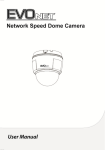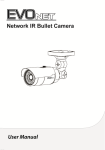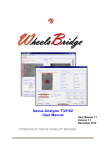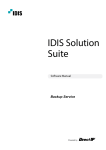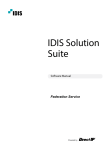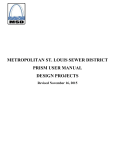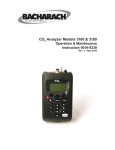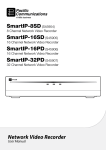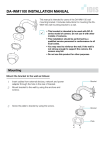Download Video Decoder
Transcript
Video Decoder Operation Manual DD-1116 Powered by Before reading this manual This operation manual contains basic instructions on installing and using DirectIP™ Video Decoder, an IDIS product. Users who are using this product for the first time, as well as users with experience using comparable products, must read this operation manual carefully before use and heed to the warnings and precautions contained herein while using the product. Safety warnings and precautions contained in this operation manual are intended to promote proper use of the product and thereby prevent accidents and property damage and must be followed at all times. Once you have read this operation manual, keep it at an easily accessible location for future reference. • The manufacturer will not be held responsible for any product damage resulting from the use of unauthorized parts and accessories or from the user’s failure to comply with the instructions contained in this operation manual. • It is recommended that first-time users of DirectIP™ Video Decoder and individuals who are not familiar with its use seek technical assistance from their retailer regarding product installation and use. • If you need to disassemble the product for functionality expansion or repair purposes, you must contact your retailer and seek professional assistance. • Both retailers and users should be aware that this product has been certified as being electromagnetically compatible for commercial use. If you have sold or purchased this product unintentionally, please replace with a consumer version. Safety Precautions CAUTION RISK OF ELECTRIC SHOCK DO NOT OPEN CAUTION: TO REDUCE THE RISK OF ELECTRIC SHOCK, DO NOT REMOVE COVER (OR BACK). NO USER-SERVICEABLE PARTS INSIDE. REFER SERVICING TO QUALIFIED SERVICE PERSONNEL. The lightning flash with arrowhead symbol, within an equilateral triangle, is intended to alert the user to the presence of uninsulated "dangerous voltage" within the product’s enclosure that may be of sufficient magnitude to constitute a risk of electric shock. The exclamation point within an equilateral triangle is intended to alert the user to the presence of important operating and maintenance (servicing) instructions in the literature accompanying the appliance. 2 Safety Precautions Safety Precautions All the safety and operating instructions should be read before the appliance is operated. 2. Retain Instructions The safety and operating instructions should be retained for future reference. 3. Cleaning Unplug this equipment from the wall outlet before cleaning it. Do not use liquid aerosol cleaners. Use a damp soft cloth for cleaning. 4. Attachments Never add any attachments and/or equipment without the approval of the manufacturer as such additions may result in the risk of fire, electric shock or other personal injury. 5. Water and/or Moisture Do not use this equipment near water or in contact with water. 6. Ventilation Place this equipment only in an upright position. This equipment has an open-frame Switching Mode Power Supply (SMPS), which can cause a fire or electric shock if anything is inserted through the ventilation holes on the side of the equipment. 7. Accessories Do not place this equipment on an unstable cart, stand or table. The equipment may fall, causing serious injury to a child or adult, and serious damage to the equipment. Wall or shelf mounting should follow the manufacturer’s instructions, and should use a mounting kit approved by the manufacturer. English Important Safeguards 1. Read Instructions 13. Servicing Do not attempt to service this equipment yourself. Refer all servicing to qualified service personnel. 14. Damage requiring Service Unplug this equipment from the wall outlet and refer servicing to qualified service personnel under the following conditions: A. When the power-supply cord or the plug has been damaged. B. If liquid is spilled, or objects have fallen into the equipment. C. If the equipment has been exposed to rain or water. D. If the equipment does not operate normally by following the operating instructions, adjust only those controls that are covered by the operating instructions as an improper adjustment of other controls may result in damage and will often require extensive work by a qualified technician to restore the equipment to its normal operation. E. If the equipment has been dropped, or the cabinet damaged. F. When the equipment exhibits a distinct change in performance - this indicates a need for service. 15. Replacement Parts When replacement parts are required, be sure the service technician has used replacement parts specified by the manufacturer or that have the same characteristics as the original part. Unauthorized substitutions may result in fire, electric shock or other hazards. 16. Safety Check Upon completion of any service or repairs to this equipment, ask the service technician to perform safety checks to determine that the equipment is in proper operating condition. 17. Field Installation This installation should be made by a qualified service person and should conform to all local codes. 18. Correct Batteries This equipment and cart combination should be moved with care. Quick stops, excessive force, and uneven surfaces may cause the equipment and cart combination to overturn. 8. Power Sources This equipment should be operated only from the type of power source indicated on the marking label. If you are not sure of the type of power, please consult your equipment dealer or local power company. You may want to install a UPS (Uninterruptible Power Supply) system for safe operation in order to prevent damage caused by an unexpected power stoppage. Any questions concerning UPS, consult your UPS retailer. 9. Power Cords Operator or installer must remove power and TNT connections before handling the equipment. 10. Lightning For added protection for this equipment during a lightning storm, or when it is left unattended and unused for long periods of time, unplug it from the wall outlet and disconnect the antenna or cable system. This will prevent damage to the equipment due to lightning and power-line surges. 11. Overloading Do not overload wall outlets and extension cords as this can result in the risk of fire or electric shock. 12. Objects and Liquids Never push objects of any kind through openings of this equipment as they may touch dangerous voltage points or short out parts that could result in a fire or electric shock. Never spill liquid of any kind on the equipment. Warning: Risk of explosion if battery is replaced by an incorrect type. Dispose of used batteries according to the instructions. 19. Tmra A manufacturer’s maximum recommended ambient temperature (Tmra) for the equipment must be specified so that the customer and installer may determine a suitable maximum operating environment for the equipment. 20. Elevated Operating Ambient Temperature If installed in a closed or multi-unit rack assembly, the operating ambient temperature of the rack environment may be greater than room ambient. Therefore, consideration should be given to installing the equipment in an environment compatible with the manufacturer’s maximum rated ambient temperature (Tmra). 21. Reduced Air Flow Installation of the equipment in the rack should be such that the amount of airflow required for safe operation of the equipment is not compromised. 22. Mechanical Loading Mounting of the equipment in the rack should be such that a hazardous condition is not caused by uneven mechanical loading. 23. Circuit Overloading Consideration should be given to connection of the equipment to supply circuit and the effect that overloading of circuits might have on over current protection and supply wiring. Appropriate consideration of equipment nameplate ratings should be used when addressing this concern. 24. Reliable Earthing (Grounding) Reliable grounding of rack mounted equipment should be maintained. Particular attention should be given to supply connections other than direct connections to the branch circuit (e.g., use of power strips). 3 Before reading this manual English In-Text Symbol Type Caution Note Description Important information concerning a specific function. Useful information concerning a specific function. User’s Caution Statement Caution: Any changes or modifications to the equipment not expressly approved by the party responsible for compliance could void your authority to operate the equipment. FCC Compliance Statement THIS EQUIPMENT HAS BEEN TESTED AND FOUND TO COMPLY WITH THE LIMITS FOR A CLASS A DIGITAL DEVICE, PURSUANT TO PART 15 OF THE FCC RULES. THESE LIMITS ARE DESIGNED TO PROVIDE REASONABLE PROTECTION AGAINST HARMFUL INTERFERENCE WHEN THE EQUIPMENT IS OPERATED IN A COMMERCIAL ENVIRONMENT. THIS EQUIPMENT GENERATES, USES, AND CAN RADIATE RADIO FREQUENCY ENERGY AND IF NOT INSTALLED AND USED IN ACCORDANCE WITH THE INSTRUCTION MANUAL, MAY CAUSE HARMFUL INTERFERENCE TO RADIO COMMUNICATIONS. OPERATION OF THIS EQUIPMENT IN A RESIDENTIAL AREA IS LIKELY TO CAUSE HARMFUL INTERFERENCE, IN WHICH CASE USERS WILL BE REQUIRED TO CORRECT THE INTERFERENCE AT THEIR OWN EXPENSE. WARNING: CHANGES OR MODIFICATIONS NOT EXPRESSLY APPROVED BY THE PARTY RESPONSIBLE FOR COMPLIANCE COULD VOID THE USER’S AUTHORITY TO OPERATE THE EQUIPMENT. THIS CLASS OF DIGITAL APPARATUS MEETS ALL REQUIREMENTS OF THE CANADIAN INTERFERENCE CAUSING EQUIPMENT REGULATIONS. WEEE (Waste Electrical & Electronic Equipment) Correct Disposal of This Product (Applicable in the European Union and other European countries with separate collection systems) This marking shown on the product or its literature, indicates that it should not be disposed with other household wastes at the end of its working life. To prevent possible harm to the environment or human health from uncontrolled waste disposal, please separate this from other types of wastes and recycle it responsibly to promote the sustainable reuse of material resources. Household users should contact either the retailer where they purchased this product, or their local government office, for details of where and how they can take this item for environmentally safe recycling. Business users should contact their supplier and check the terms and conditions of the purchase contract. This product should not be mixed with other commercial wastes for disposal. 4 Before reading this manual English Copyright © 2014 IDIS Co., Ltd. IDIS Co., Ltd. reserves all rights concerning this operation manual. Use or duplication of this operation manual in part or whole without the prior consent of IDIS Co., Ltd. is strictly prohibited. Contents of this operation manual are subject to change without prior notice for reasons such as functionality enhancements. Registered Trademarks IDIS is a registered trademark of IDIS Co., Ltd. Other company and product names are registered trademarks of their respective owners. The information in this manual is believed to be accurate as of the date of publication. We are not responsible for any problems resulting from the use thereof. The information contained herein is subject to change without notice. Revisions or new editions to this publication may be issued to incorporate such changes. The software included in this product contains some Open Sources. You may obtain the complete corresponding source code from us. See the Open Source Guide on a printed document included along with the User’s Manual. 5 Table of Contents 1 Part 1 - Introduction 8 Product Features. . . . . . . . . . . . . . . . . . . . . . . . . . . . . . . . . . . . . . . . . . . . . . . . . . . . . . . . . . . . . . . . . . . . . . . . . . . . 8 Accessories. . . . . . . . . . . . . . . . . . . . . . . . . . . . . . . . . . . . . . . . . . . . . . . . . . . . . . . . . . . . . . . . . . . . . . . . . . . . . . . . . 10 Overview. . . . . . . . . . . . . . . . . . . . . . . . . . . . . . . . . . . . . . . . . . . . . . . . . . . . . . . . . . . . . . . . . . . . . . . . . . . . . . . . . . 10 Front Panel. . . . . . . . . . . . . . . . . . . . . . . . . . . . . . . . . . . . . . . . . . . . . . . . . . . . . . . . . . . . . . . . . . . . . . . . . . . . . . . . . . . . . . . . . 10 Rear Panel. . . . . . . . . . . . . . . . . . . . . . . . . . . . . . . . . . . . . . . . . . . . . . . . . . . . . . . . . . . . . . . . . . . . . . . . . . . . . . . . . . . . . . . . . . 11 Rear Panel Connections. . . . . . . . . . . . . . . . . . . . . . . . . . . . . . . . . . . . . . . . . . . . . . . . . . . . . . . . . . . . . . . . . . . . . . . . . . . . . 12 2 Part 2 - Getting Started 14 Login . . . . . . . . . . . . . . . . . . . . . . . . . . . . . . . . . . . . . . . . . . . . . . . . . . . . . . . . . . . . . . . . . . . . . . . . . . . . . . . . . . . . . . 14 Live Mode. . . . . . . . . . . . . . . . . . . . . . . . . . . . . . . . . . . . . . . . . . . . . . . . . . . . . . . . . . . . . . . . . . . . . . . . . . . . . . . . . . 15 Live Menu. . . . . . . . . . . . . . . . . . . . . . . . . . . . . . . . . . . . . . . . . . . . . . . . . . . . . . . . . . . . . . . . . . . . . . . . . . . . . . . . . . . . . . . . . . 15 Event Monitoring. . . . . . . . . . . . . . . . . . . . . . . . . . . . . . . . . . . . . . . . . . . . . . . . . . . . . . . . . . . . . . . . . . . . . . . . . . . . . . . . . . . 18 Covert Camera. . . . . . . . . . . . . . . . . . . . . . . . . . . . . . . . . . . . . . . . . . . . . . . . . . . . . . . . . . . . . . . . . . . . . . . . . . . . . . . . . . . . . . 18 Context Menu Access. . . . . . . . . . . . . . . . . . . . . . . . . . . . . . . . . . . . . . . . . . . . . . . . . . . . . . . . . . . . . . . . . . . . . . . . . . . . . . . 19 Edit Group. . . . . . . . . . . . . . . . . . . . . . . . . . . . . . . . . . . . . . . . . . . . . . . . . . . . . . . . . . . . . . . . . . . . . . . . . . . . . . . . . . . . . . . . . . 19 ㅈ 3 Part 3 - Configuration 20 Menu Use. . . . . . . . . . . . . . . . . . . . . . . . . . . . . . . . . . . . . . . . . . . . . . . . . . . . . . . . . . . . . . . . . . . . . . . . . . . . . . . . . . 20 Text Input via Virtual Keyboard. . . . . . . . . . . . . . . . . . . . . . . . . . . . . . . . . . . . . . . . . . . . . . . . . . . . . . . . . . . . . . . . . . . . . . 20 Mouse. . . . . . . . . . . . . . . . . . . . . . . . . . . . . . . . . . . . . . . . . . . . . . . . . . . . . . . . . . . . . . . . . . . . . . . . . . . . . . . . . . . . . . . . . . . . . . 21 System Setup . . . . . . . . . . . . . . . . . . . . . . . . . . . . . . . . . . . . . . . . . . . . . . . . . . . . . . . . . . . . . . . . . . . . . . . . . . . . . . 21 General. . . . . . . . . . . . . . . . . . . . . . . . . . . . . . . . . . . . . . . . . . . . . . . . . . . . . . . . . . . . . . . . . . . . . . . . . . . . . . . . . . . . . . . . . . . . . 21 Date/Time. . . . . . . . . . . . . . . . . . . . . . . . . . . . . . . . . . . . . . . . . . . . . . . . . . . . . . . . . . . . . . . . . . . . . . . . . . . . . . . . . . . . . . . . . . 22 User. . . . . . . . . . . . . . . . . . . . . . . . . . . . . . . . . . . . . . . . . . . . . . . . . . . . . . . . . . . . . . . . . . . . . . . . . . . . . . . . . . . . . . . . . . . . . . . . 22 Camera Setup. . . . . . . . . . . . . . . . . . . . . . . . . . . . . . . . . . . . . . . . . . . . . . . . . . . . . . . . . . . . . . . . . . . . . . . . . . . . . . 25 General. . . . . . . . . . . . . . . . . . . . . . . . . . . . . . . . . . . . . . . . . . . . . . . . . . . . . . . . . . . . . . . . . . . . . . . . . . . . . . . . . . . . . . . . . . . . . 25 NVR Scan. . . . . . . . . . . . . . . . . . . . . . . . . . . . . . . . . . . . . . . . . . . . . . . . . . . . . . . . . . . . . . . . . . . . . . . . . . . . . . . . . . . . . . . . . . . 25 6 Table of Contents Display Setup . . . . . . . . . . . . . . . . . . . . . . . . . . . . . . . . . . . . . . . . . . . . . . . . . . . . . . . . . . . . . . . . . . . . . . . . . . . . . . 26 English OSD. . . . . . . . . . . . . . . . . . . . . . . . . . . . . . . . . . . . . . . . . . . . . . . . . . . . . . . . . . . . . . . . . . . . . . . . . . . . . . . . . . . . . . . . . . . . . . . . 26 Main Monitor. . . . . . . . . . . . . . . . . . . . . . . . . . . . . . . . . . . . . . . . . . . . . . . . . . . . . . . . . . . . . . . . . . . . . . . . . . . . . . . . . . . . . . . 26 4 Part 4 - Appendix 27 System Log Types . . . . . . . . . . . . . . . . . . . . . . . . . . . . . . . . . . . . . . . . . . . . . . . . . . . . . . . . . . . . . . . . . . . . . . . . . . 27 Error Code Types . . . . . . . . . . . . . . . . . . . . . . . . . . . . . . . . . . . . . . . . . . . . . . . . . . . . . . . . . . . . . . . . . . . . . . . . . . . 28 Troubleshooting. . . . . . . . . . . . . . . . . . . . . . . . . . . . . . . . . . . . . . . . . . . . . . . . . . . . . . . . . . . . . . . . . . . . . . . . . . . . 30 Specifications. . . . . . . . . . . . . . . . . . . . . . . . . . . . . . . . . . . . . . . . . . . . . . . . . . . . . . . . . . . . . . . . . . . . . . . . . . . . . . 31 Index . . . . . . . . . . . . . . . . . . . . . . . . . . . . . . . . . . . . . . . . . . . . . . . . . . . . . . . . . . . . . . . . . . . . . . . . . . . . . . . . . . . . . . 32 7 Part 1 - Introduction Product Features This video Decoder compresses live video from network cameras and transmits the video over Ethernet connections. This encoder offers the following features: • 16 composite video output connectors (HDMI, VGA, CVBS) • Real time network surveillance • H.264 compression algorithm • DirectIPTM protocol supported • Convenient firmware upgrades using usb ports • Firmware duplication and autorecovery functions to enhance system stability • Event detection functions: motion, video loss, tampering 8 Part 1 - Introduction Video Decoder Connection Diagram English Dir ect IP™ Sw itch IP Camera 6 Video Decoder CAUTION RISK OF ELECTRIC SHOCK DO NOT OPEN CAUTION : TO REDUCE THE RISK OF ELECTRIC SHOCK. DO NOT REMOVE COVER (OR BACK). NO USER-SERVICEABLE PARTS INSIDE. REFER SERVICING TO QUALIFIED SERVICE PERSONNEL. 5 VIDEO VIDEOIN IN AUDIO IN NC C NO ARI G RS-485 - + VIDEO IN / PoE Ext. Ext. A C E G NETWORK CLIENT B D F H 100-240V~ eSATA AUDIO OUT VGA OUT HDMI 1 3 2 4 A/1 A/2 A/3 A/4 G Tx Rx RS -232 NVR (Network Video Recorder) Types of Cables 1 LAN Cable (Data + PoE Power) 2 CVBS Output Cable 3 VGA Output Cable 4 HDMI Output Cable 5 LAN Cable 6 LAN Cable 9 Part 1 - Introduction English Accessories Upon unpacking the product, check the contents inside to ensure that all the following contents are included. • Video Decoder • User Guide and Instruction Manual (This document) Overview Front Panel 1 3 1 Power LED 2 Network LED 2 3 Factory Reset Switch 1 Power LED Displays system operating status 2 Network LED Displays network connection status LED Status Indications LED Status Off Power LED Blinking Network LED Blinking lights Description No power connection System booting or upgrading System operating Normal network connection 3 Factory Reset Switch Use to return all settings to the original factory settings. Connect the power and poke a straightened paperclip into the factory reset switch hole. Hold the reset switch until the encoder’s internal buzzer sounds twice. Release the reset switch, and all of the encoder’s settings are now at the original settings it had when it left the factory. 10 Part 1 - Introduction Rear Panel English 1 1 DC12V In 2 2 3 Network + PoE Power In 3 4 Video Out 4 USB (2 Ports) 1 DC12V In Connect the two wires of the power adapter to these ports. Be careful not to cross the DC12V and ground (GND) wires. Booting will commence once connected to a power supply. 2 Network + PoE Power In Connect a Cat5e cable with an RJ-45 jack. The video decoder is capable of connecting to networks via an Ethernet connector and also reveives power from the NVR that is capable of PoE function and LAN cable from Switch Hub. 3 Video Out Connect video output ports (CVBS, VGA, HDMI). coaxial cables from the video sources. 4 USB (2 Ports) Connect the two USB ports. •• The network connector is not designed to be connected directly with cable or wire intended for outdoor use. • Press down on the button and insert the cable into the opening when you connect the DC12V power connectors. Release the button and then pull on the cable slightly to ensure it is held securely in place. To disconnect the cable, press down on the button again and pull the cable out. • Ground the power port’s ground terminal before use. • Organize the power cable so that it will not cause people to trip over or become damaged from chairs, cabinets, desks, and other objects in the vicinity. Do not run the power cable underneath a rug or carpet. • Do not connect multiple devices to a single power outlet. 11 Part 1 - Introduction Rear Panel Connections English 2 Power Cable Connection Monitor Connection Connect to the VGA OUT or 3 HDMI port. 4 This video decoder does not feature a separate power on/ off button and will turn on the moment power is supplied. Connect the connector(12V) of adapter to the NVR and then connect the AC power cable of adapter to the power outlet. Video Connection ●● Video In/PoE Factory Reset Connect switch or the NVR using RJ-45 cable (Cat5, Cat5e, or Cat6). Located next to the Power LED port on the front of the video decoder is a switch that, once activated, will reset the video decoder to all its initial factory settings. •• Green LED on the right will turn on when PoE comes on line. Orange LED on the left will then flash once a link has been established. •• If more than 16 cameras from video encoders are registered on the NVR, video may not be displayed smoothly in a remote program. A factory reset will clear all video decoder settings configured by the user. You will need a straightened paper clip to access the factory reset button. 1 Turn off the video decoder. 2 Insert a straightened paper clip into the factory reset switch hole and press the switch. Turn on the video decoder while holding the switch. 3 Press and hold until you hear 2 beeps from the video decoder’s internal buzzer. 4 All video decoder settings will be returned to their factory values once you remove the paper clip. 12 Part 1 - Introduction Connections on the Rear Panel English 12V Power CVBS Monitor D ire ™ IP ct h itc Sw VGA Monitor DirectIP™ Gigabit PoE Switch Camera HDMI MonitorS D ™ IP ct ire VR N DirectIP™ NVR 13 Part 2 - Getting Started Login Configuring the video decoder’s settings and other functions require an authorized user login. 1 Bring up the Live menu and click on (Login) using the mouse. •• Click on the button next to the password field using the mouse. This will bring up a virtual keyboard you can use to assign a password. For more information on using the virtual keyboard, refer to the Text Input via Virtual Keyboard on page 20. 3 To log out, bring up the Live menu and click on using the mouse. 2 Select a user, enter the password, and then select OK. 14 (Log out) Part 2 - Getting Started Live Mode English Live Menu Place the mouse pointer on the top of the screen while in Live mode to bring up the Live menu. 1 3 2 4 5 6 7 8 1 Login/Logout 2 Layout 3 Previous Group, Next Group 4 Display 5 Sequence 6 Select Camera 7 Setup 8 Status Indication 1 Login/Logout Log into and out from accounts. If in the logged in state, the account ID is shown. If in the logged out state, the login icon is shown. 2 Layout Used to change the screen layout to single screen, 2x2, 3x3, or 4x4. 3 Previous/Next Group Loads the previous/next screen group. 4 Display •• OSD (On Screen Display): Enables/disables the OSD feature. •• Full: Displays the video in full screen mode. •• Aspect Ratio: Select whether to enable the original aspect ratio of video transmitted from the camera. 5 Sequence Initiates Sequence while in Live mode. To exit, select Sequence once more. The of the screen while Sequence is in progress. icon is displayed on the upper right part 15 Part 2 - Getting Started Full Sequence English Displays all channels in sequence while in Live mode (single and split screen settings). In order to use the Full Sequence feature, Full Sequence (Display Setup - Main Monitor > Sequence) must first be enabled. e.g.) Full Sequence in 2x2 split screen mode 7 Setup Used to access the Setup menu. 8 Status Indication Displays system status icons. Status Indication Indicates Sequence is in use. Cameo Sequence In Cameo Sequence mode, only the bottom right screen in a split screen setup changes sequence. In order to use the Cameo Sequence feature, Cameo Sequence (Display Setup - Main Monitor > Sequence) must first be enabled. e.g.) Cameo Sequence in 2x2 split screen mode •• If using the Full Sequence setting, page numbers appear on the system status area on the upper right part of the screen, next to the Sequence icon. •• Pages are skipped under the following circumstances: –– If all cameras included in the page are deactivated. –– If there are no video signals. –– If the page contains "covert" cameras. –– If the user does not have permission to view feeds from the cameras. 6 Select Camera Displays the selected camera in a single screen format. 16 1/4 Indicates the current screen's group. Indicates an event monitoring. Part 2 - Getting Started PTZ Control English While in Live mode, right-click and select PTZ from the context While in PTZ mode, place the mouse pointer close to the bottom edge of the screen to display the PTZ Tools window. menu to display the PTZ camera selection window. Setting Up a PTZ Preset While in the PTZ Tools window, select the icon to display the Set Preset window and assign the current position as a preset. Select the camera you wish to control. The icon will begin to flash on the selected camera’s OSD window. Use the Arrow buttons to pan and tilt the camera up, down, left, and right. You can also change the direction by dragging on the mouse. Also, it’s possible to use the mouse wheel to zoom in/out. •• Logging in with an account that has PTZ Control Authority is necessary in order to control PTZ cameras. •• To exit PTZ mode, right-click on the mouse, open up the Context Menu and then select the PTZ exit. 17 Part 2 - Getting Started English While in the PTZ Tools window, select the icon to display the Move to Preset window. Select a preset to move the current PTZ camera to the selected preset’s position. PTZ Camera Pan and Tilt Zoom In/Out Focus Near / Far IRIS Open / Close One Push Set / Move to Preset Advanced PTZ •• While in one push, the message “Focusing...” will prompt on the screen. •• Drag and drop to reposition the PTZ Tools window. Advanced Settings In PTZ mode, selecting a camera and then right-clicking on the right loads the Advanced PTZ screen as shown below. This menu lists Speed, Auto Pan, and other advanced PTZ camera control options available for the camera. Options that are not available for the selected PTZ camera remain inactive. You can use the mouse to control PTZ cameras. Left-click on the mouse and drag to move the camera in the desired direction and use the mouse wheel to zoom in/out. 18 •• Select the icon to hide the PTZ Tools window. Event Monitoring When an event occurs, the NVR automatically displays the icon on the channel linked to the event and shows the system status area on the upper right portion of the screen. To use the Event Monitoring feature, navigate to Display > Main Monitor and enable Event Monitoring. Event Monitoring remains in effect throughout the entire Event Monitoring Time. After that, the NVR will return to the previous screen if a new event does not take place. Pressing the Layout or a Camera button before the end of the Event Monitoring Time reverts the system to Live mode. Part 2 - Getting Started Covert Camera •• Covert 2: The camera is indicated as being inactive. Images from the camera are not shown. Camera title and status icons are not shown. Users that have a cover Covert Camera View are able to view both images from and status icons for all Covert 1 and Covert 2 cameras. English Use this feature to assign Covert Camera View permissions. Navigate to Camera Setup > General and designate cameras as Covert 1 or Covert 2. •• Covert 1: Hides images from the camera in Live mode but does indicate the camera’s title and status via icons. Context Menu Access While in Live mode, ,right-click on the mouse to access the Context menu. •• PTZ: Access PTZ controls. •• Information: Select a network channel to display information about the selected channel’s device. •• Edit Group: Rearrange the split screen layout. •• Login/Logout: Log into the account or log out of the account. Edit Group Edit Group lets you customize split screen pages in Live mode. 1 While displaying a split screen page, select the Edit Group option from the context menu. A yellow border is drawn around the page. Use the mouse to select a different page. 2 Press a Camera button or select a camera after pressing the Menu button. Selected camera is then loaded on to the selected page. Repeat to assign other channels to the page. 3 Right-click on the mouse, open up the Context Menu and then select Exit Group Edit to exit. 19 Part 3 - Configuration Menu Use Information contained in this section (Menu Use) applies to all other instructions found throughout Part 3 - Configuration. Login with an ID that has permission to access the setup menu is needed to access and make changes to the Setup menu. 3 Change the setting and then select Apply or OK to save the change. To apply default settings, select the Default button located on the left bottom corner of the setup window. Text Input via Virtual Keyboard Click on the key using the mouse to select a virtual keyboard key. 1 While in Live mode, select Live menu > Setup using the mouse. 1 2 3 Toggle case. 1 System Setup 2 Camera Setup 3 Display Setup Deletes the character to the left of the cursor. Deletes the character to the right of the cursor. Converts keyboard. 2 Left-click on the mouse to select an option. 20 Part 3 - Configuration Mouse If an upgrade attempt fails, an upgrade failure message will be displayed. Refer to Error Code Types on page 28 for more details. System Setup Refer to the Menu Use on page 20 for basic information on using the Setup menus. General This Setup menu contains general system options. •• Setup: Exports current video decoder settings or imports existing settings. •• Import: Imports the current system settings to a storage device connected to the system’s USB port. Selecting Setup Import does not change the settings below. •• Time-related settings (Date/Time, Time Zone, and Use Daylight Saving Time) •• Export: Exports the current system settings to a storage device connected to the system’s USB port. You can designate a File Name for the export file. •• Site: Used to enter a description about the system’s installation site (no description by default). You can edit the information using the virtual keyboard. For USB flash memory devices, the NVR supports the FAT32 file format only. •• Language: Choose a language. •• Version: Indicates the software version. •• Show System Log: Displays a searchable list of 5,000 most recent system log entries. For more information on types of system log entries, refer to the System Log Types on page 27. To export the system log, select the Export at the bottom of the screen and then designate a file name. In order to display the system_log.txt file, you must use the correct character encoding settings and use a fixed-width font. 21 English Using a mouse makes it easy to configure the settings. A mouse lets you make selections faster and use its wheel to scroll through long menus. You can also use the mouse wheel to increase/decrease numerical values. •• Upgrade: Select to upgrade the system. Selecting Upgrade displays the USB search window. You will then be able to select an upgrade package and upgrade the system. Once the upgrade is complete, the NVR will reboot automatically. Part 3 - Configuration English •• System Shutdown: Shuts down the system. When prompted, select System Shutdown. User Use this option to register users and assign permissions. The system will restart after changing the channel mode. Date/Time 1 Select + Group and enter a group name. A group name can be up to 15 characters in length. 2 Specify the group’s permission settings. For more •• Date: Used to change the system’s date setting. •• Time: Used to change the system’s time setting. information on permission settings, refer to the Group Permissions on page 24. •• Date Format/Time Format: Used to change the system’s date and time formats. •• Time Zone: Used to designate the system’s time zone. Refer to the map displayed on the screen and change the time zone using the mouse or the arrow buttons. •• Use Daylight Saving Time: Enables DST correction. 3 Select + User and then enter a user name. 22 Part 3 - Configuration 4 Select a group for the user and then enter a password. 5 Select OK. 6 Configure Auto Login and Auto Logout settings. 7 Select Apply or OK to exit. •• Group names, user names, and passwords can be entered using the virtual keyboard. For more information on using the virtual keyboard, refer to the Text Input via Virtual Keyboard on page English The password can be up to 16 characters in length and Time Zone: Used to designate the system’s time zone. 20. •• To delete a registered user or group, select the icon on the right of the corresponding user/group. Group Administrator and User admin cannot be deleted. icon next to Group & User on the •• Select the top of the screen to delete all groups and users except Group Administrator and User admin simultaneously. •• A password entry is required to edit existing groups and users. •• Group Administrator's permissions cannot be changed. •• With the User admin account, only the password can be changed. •• When the system starts up, it will automatically log into the account designated under Auto Login. •• The system will automatically log out of the account if the duration of inactivity specified under Auto Logout. 23 Part 3 - Configuration Group Permissions English System Shutdown May shutdown the system from the system menu. Upgrade May upgrade the system from the system menu (System Setup). PTZ Control May control PTZ cameras. Covert Camera View May access covert cameras in Live mode. Setup 24 Covert Camera Setup May configure convert camera settings. Setup Import May import previously saved video decoder settings. Setup Export May export current video decoder settings. Part 3 - Configuration Refer to the Menu Use on page 20 for basic information on using the Setup menus. General NVR Scan English Camera Setup Used to scan and register the NVR connected to the video decoder. Scan the connected NVR and then login to register the camera. The cameras that were scanned to the NVR will be registered to the video decoder automatiaclly. Enable/disable the covert view and rename cameras. •• Title: Edit the camera’s name. •• Use: Set the camera as Normal, Covert 1, or Covert 2. Live images and video recordings from cameras that have been set as Covert 1 or Covert 2 will not be available to users who do not have covert camera access. Setting a camera as Covert 1 hides its images but does display OSD information about the camera. Setting a camera as Covert 2 hides its images as well as ODS information about the camera as if it has been deactivated completely. 25 Part 3 - Configuration Display Setup Main Monitor English Refer to the Menu Use on page 20 for basic information on using the Setup menus. Configure monitor-related settings. OSD Show OSD (On Screen Display) information on the bottom of the screen. •• Mode: Select Full Sequence or Cameo Sequence. •• Interval: Select between 3 secs and 2 mins. For more information on Sequence, refer to the Full Sequence on page 16. Status •• Date and Time: Displays the date and time. •• No.: Displays the camera number on the upper left corner of the camera screen. •• Title: Displays the camera name on the upper left corner of the camera screen. icon on PTZ cameras. •• PTZ Zoom: Displays the zoom magnification (e.g. x2, x3, etc.) 26 •• Manual Configuration: Set the resolution manually regardless of the resolution supported by the monitor. •• Resolution: Select 1920 x 1200, 1920 x 1080, 1680 x 1050, 1600 x 1200 Camera •• PTZ: Displays the •• Event Monitoring On: With Event Monitoring enabled, video feed from the camera configured to start recording when an event occurs is shown on the screen. Select between 5 secs and 15 mins. For more information on Event Monitoring, refer to the Event Monitoring on page 18. Part 4 - Appendix English Part 4 - Appendix System Log Types Boot Up Login System Shutdown Logout Restart Setup Begin Upgrade Success Setup End Upgrade Error Setup Import Power Failure Setup Import Failure Time Changed Setup Export Time Zone Change Setup Export Failure Time Sync. Setup Export Canceled Time Sync. Failed Factory Reset 27 Part 4 - Appendix Error Code Types English Upgrade Error Codes No. Type No. Type 0 Unknown Error 400 USB Storage Device Mount Failure 1 Incorrect File Version 401 USB Storage Device File Read Failure 2 Incorrect OS Version 402 USB Storage Device File Copy Failure 3 Incorrect Software Version 403 USB Device Not Connected 4 Incorrect Kernel Version 404 USB Storage Device in Use 100 Storage Device Mount Failure 405 Unsupported File System 101 File Not Found 102 File Decompression Failure 103 LILO Execution Failure 104 Reboot Failure 105 Improper File Network Error Codes No. 28 Type No. Type 0 Cause of Failure Unknown 20 Connection Cancelled by User 1 Normal Logout 21 No Response from Network Device Host 2 All Channels in Use - Connection Denied 22 High Network Noise Level 3 Incorrect Product Version Info 23 Transmission Queue Full 4 Incorrect User Name or Password 24 Incorrect OEM Info 5 Forced Disconnection by Admin 25 No Search Permission 6 Timeout 26 Port in Use 7 Network Device Terminated 27 SSL Connection Failure 8 Unable to Connect: No Available Port 28 Network Timeout 9 Server Not in Operation: Unable to Connect 29 Network Device Host Timeout Part 4 - Appendix Network Unavailable 30 RTP via TCP Not Supported by Network Device Host 12 Different Network Zone: Unable to Access 31 Socket Error 13 Connection Timeout 100 Unknown CODEC 14 Forced Disconnection by Network Device 101 .jpeg CODEC (not supported) 15 Network Device Host Terminated 103 .mpeg4 CODEC (not supported) 16 Unable to Route to Network Device Host 400 Unsupported Resolution 17 Connection Severed -1 English 11 Normal Access 29 Part 4 - Appendix Troubleshooting English Problem The main unit won't turn on. Solution •• Check the power cable connection status. •• Check the power outlet. •• Check the camera's video cable connection status. Unable to display Live video. •• Check the monitor's video cable connection status. •• Check the camera's power setting. •• Check the camera lens settings. The video decoder keeps on rebooting during a system upgrade without completing the upgrade. The system is unable to recognize network interface 30 Check the upgrade file’s version. To downgrade to a previous version, you must first press the factory reset button and reset all NVR settings to their factory defaults. A factory reset will clear all NVR settings configured by the user. For more information on factory reset, refer to the Factory Reset section on page 90. • Check the LAN cable. • Check the network LED. Part 4 - Appendix Model Video Inputs/ Outputs Environmental Conditions General English Specifications DD-1116 Output 16 ch Compression H.264 Resolution 1920x1200, 1920x1080, 1680x1050, 1600x1200 Bitrate Control VBR Video Output HDMI, VGA, CVBS Ethernet 10M/100M/1Gbps DC12V Input Terminal Blocks LED Power(Status), Network Button/Switch Reset Operating Temperature 32°F to 104°F (0°C ~ 40°C) Operating Humidity 0% ~ 90% Dimensions (W x H x D) 7.9” x 1.7” x 5.7” (200mm x 44mm x 145mm) Shipping Dimensions (W x H x D) 10.1” x 4.1” x 7.4” (258mm x 103mm x 188mm) Unit Weight TBD Shipping Weight TBD Power Supply DC12V or PoE (IEEE802.3af class0) Power Consumption Max. 12W Approval FCC, CE, KC These product specifications may change without prior notice. 31 Part 4 - Appendix Index English E Event Monitoring 18 L Live Mode 15 Login 14 M Mouse 21 O OSD 26 P PTZ Control 17 32 Ver. 1.0 IDIS Co., Ltd. For more information, please visit at www.idisglobal.com


































